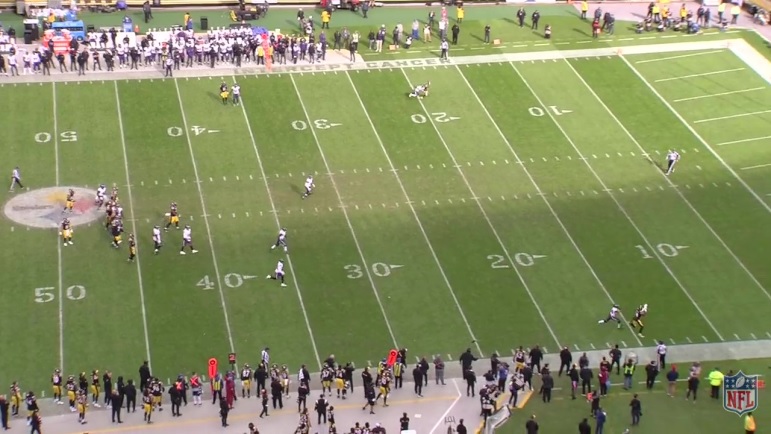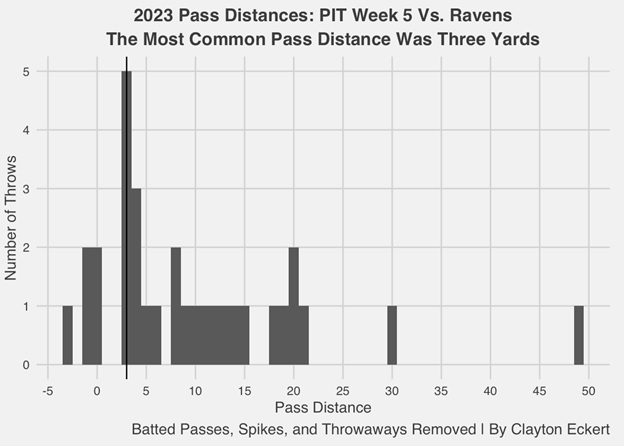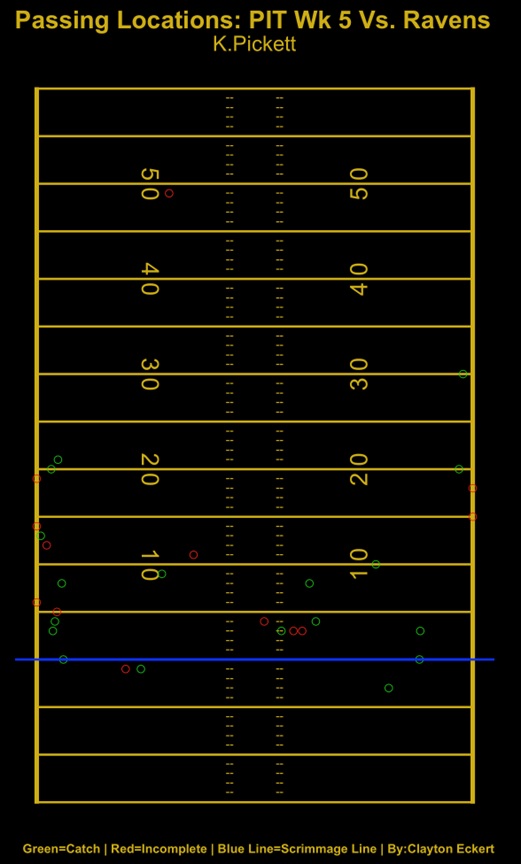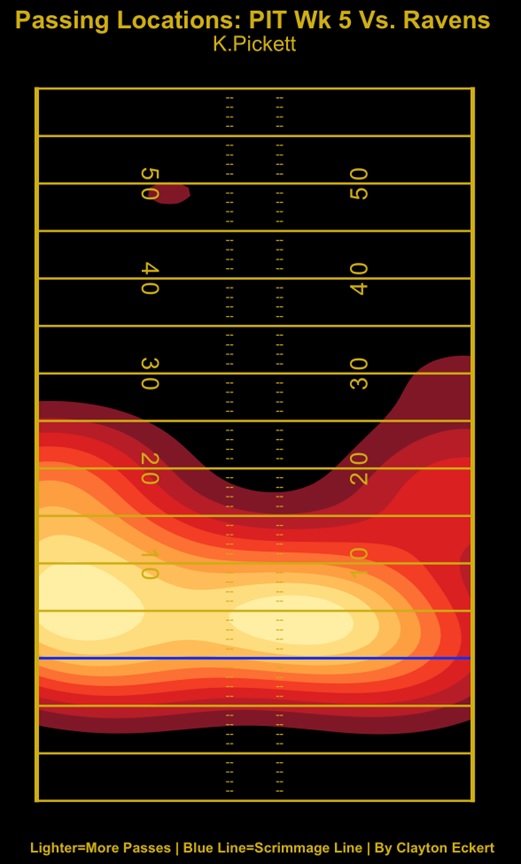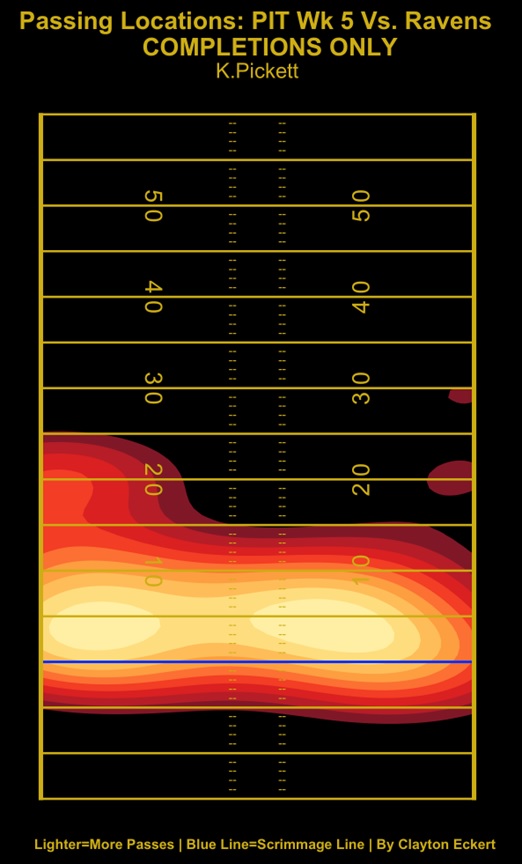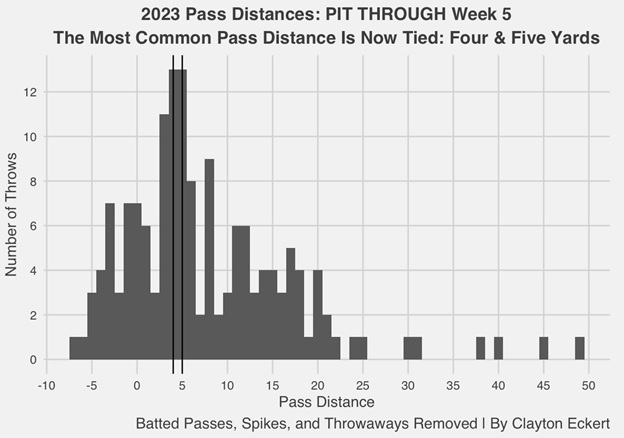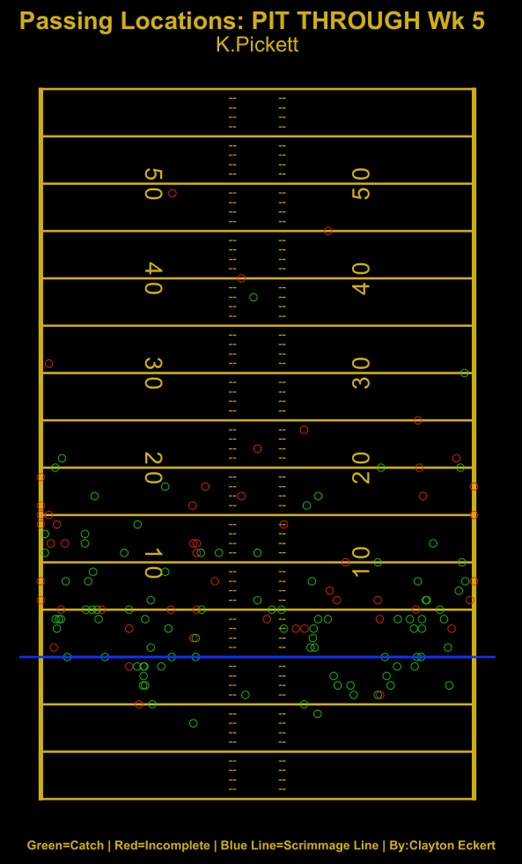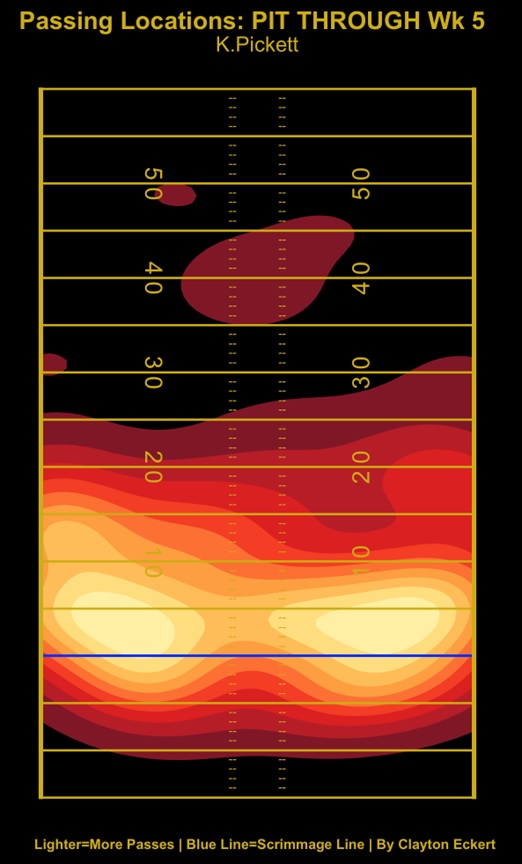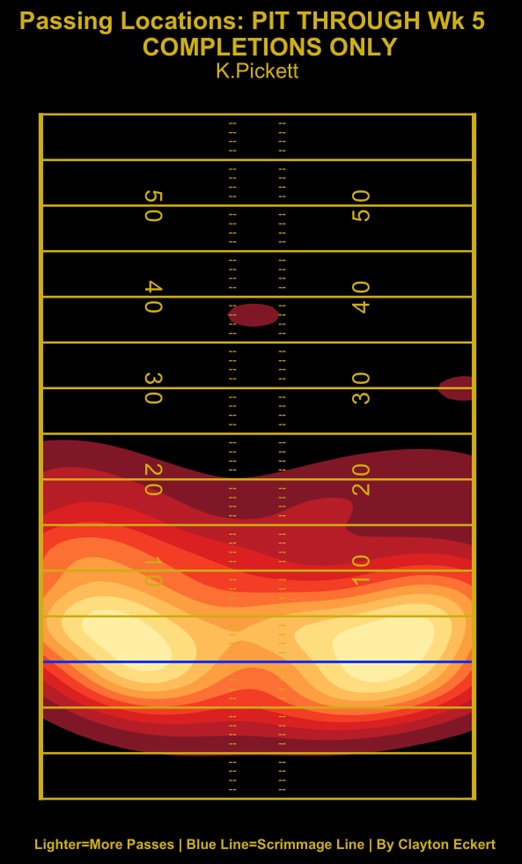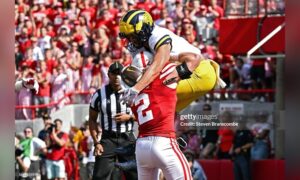Pittsburgh now sits on top in the AFC North following a crucial 17-10 rivalry win over Baltimore. For the second season, I am charting, visualizing, and providing takeaways for the all-important quarterback position for the Pittsburgh Steelers.
A couple of notes before we jump in. Thanks to Thomas Mock for his great work that helped me learn much of what I’m using in the series visually. Spikes and clear throwaways are removed due to being the correct situational decision, along with batted passes at the line of scrimmage that affect the intended pass location. This week, one throwaway was removed.
It was a performance on offense we’ve grown accustomed to, starting slow and doing just enough in the fourth quarter to get the win. On the stat sheet, QB Kenny Pickett went 18/32 (56.3 percent) for 224 yards, the excellent go-ahead touchdown late, no interceptions, an 88.5 passer rating, and taking three sacks in consecutive weeks.
Despite the latter, Pickett got the ball out quicker, and the o-line protected well overall. In the process, Pickett had a better day than last week for sure, bailing clean pockets less and showing toughness following last week’s injury. I did note more accuracy issues, but a step in the right direction going into the bye (albeit low bar).
Let’s start with a simple view of the 31 charted passes, with the number of throws at each pass distance for the game:
#1. 0-5 air yards: 35.5 percent. The most common pass distance as usual. The first pass of the game was on third and six, gaining just that on an encouraging opening drive conversion, an out route to TE Connor Heyward. Another was late in the progression, finding WR Allen Robinson who made the tough three-yard catch, taking hard hits most of the game.
Quick throw on a stop route to Robinson to start the third quarter, for four yards. Then, a quick pivot route over the middle to Heyward for five yards. The next second and ten, Pickett spun left away from the rush (LT Broderick Jones recovered), finding Robinson late on the crosser for another tough four-yard catch. RB Jaylen Warren had a catch in the flat at three air yards with space on a third and six conversion, nearly breaking a tackle, but stepping out of bounds for ten yards.
In the fourth quarter, Warren’s next catch in the flat was at the line of scrimmage, with excellent explosive YAC for 23 yards, refusing to go down with a forced missed tackle and churn. It was a big play that eventually led to the offense’s only red zone trip (field goal). Late in the game, Heyward was hit on a stop route, jarring the ball incomplete. Another was broken up on a slant to Robinson.
T-second: 5-10 air-yards: 19.4-percent. The first example was a quick out sliding left, thrown a bit high to Robinson who made the jumping catch for eight yards. Moving left again, Pickett reads and has Heyward wide open against zone right in front of him, finally seeing him late in the progression for his second conversion on third and six for 12 yards. You guessed it, out route sliding left, but this one was overthrown to Robinson sailing out of bounds.
WR George Pickens had a great game and interestingly had just one air-yard target under ten yards (eight), a good throw and catch on an in-breaker over the middle, staying up on the hit for an 11-yard gain. On the final touchdown drive, Robinson got open against zone, a stop route at ten yards for a big third and nine conversion. Big, overlooked play.
T-second: 10-15 air-yards: 19.4-percent. Mostly back-shoulder throws here, starting with two third-down fails to Pickens and WR Calvin Austin III, the latter tripping, and both throws short of the receiver. To end the third quarter, it connected for 13 yards, a nice throw and toe-tap from Pickens.
From seven yards out in the fourth quarter, Pickens ran a quick corner route that was well covered and broken up in the end zone, another underthrow from Pickett. The following red zone play was a slant to Robinson, who lost his footing and sailed out of the end zone on third and goal. Their only red-zone trip resulted in a field goal.
T-fourth: 15-20 air-yards: 16.1-percent. Another back-shoulder here, underthrown to Austin again going out of bounds. In the third quarter, Pickett was a bit antsy with G Isaac Seumalo getting pushed back (recovered), creating a scramble drill and throwing incomplete to Robinson on the sideline against tight coverage.
T-fourth: Explosive (20 yards or more): 16.1-percent. Higher frequency and success encouragingly, exclusively to Pickens. First, a nice second-quarter back-shoulder throw, toe-tapping it for 21 yards, surprisingly his first contested catch of the year. Next was the longest air yards by far (49), overthrown to the end zone, but seemingly wasn’t at full speed on his go route. In the third quarter, Pickett enjoyed great protection, with a good throw and corner route for 23 yards.
In the final two plays of the game, the back shoulder worked on a weighty third and four, a huge contested catch for 21 yards. Then, an even bigger play, the go-ahead touchdown on the go route, a dime at 30 air yards with separation and 11 in YAC. The Pickett-to-Pickens connection was clutch late for back-to-back explosive plays.
#6. 9.7-percent behind the line. Least common, encouragingly. One was an off-target throw to TE Darnell Washington in the flat on third and ten. One was an interesting fake jet sweep, screen to RB Najee Harris to the other side, gaining three yards. A target to Warren was the best result, at -3 air yards on the gain of six.
Here are the dots of completions and incompletions for week five:
Holy sidelines. Pickett loves the back-shoulder throw in single coverage, which has largely been unavailable until this week. He was like a kid in the candy store, devouring those opportunities. He favored the left and went 50 percent (7/14) outside the numbers. More success to the right, going 6/8 outside the numbers (75 percent) including the touchdown. Barren chart past ten yards between the numbers, with two incompletions including the longest air-yard attempt of 2023. 4/7 (57.1 percent) short between the numbers, and only one attempt between the hashes, incomplete.
Now for the heat maps, with all the charted passes for the game, then completions only:
Both visuals really highlight the lack of throws to the middle of the field, as we’ve discussed ad nauseam. The longest completions between the numbers were eight and nine air yards, the Pickens in-breaker and Heyward late read conversion. Good results, but need more frequency and depth to make it tougher on defenses. Hopefully post-bye, but don’t hold your breath. More throws and success in the explosive range than in prior weeks were most encouraging, with four explosive air-yard completions after just two in the first four games combined. MORE!
Now let’s look at all 154 charted throws this season, with frequencies by distance and previous averages:
#1. 0-5 air-yards: Season 34.4-percent. Previously 34.1-percent.
#2. 5-10 air-yards: Season 24.0-percent. Previously 25.2-percent.
T-third. Behind the line: Season 16.9-percent. Previously 18.7-percent.
T-third. 10-15 air-yards: Season 16.9-percent. Previously 16.3-percent.
#5. 15-20 air-yards: Season 13.6-percent. Previously 13.0-percent.
#6. Explosive: Season 9.7-percent. Previously 8.1-percent.
10-15 air yards moved up the ranks, tying for the third most common pass distance. 0-5 air yards is still on the uptick, along with 15-plus yards. Also encouraging is the biggest change in the rates, a decrease in behind-the-line passing.
Here are dots for all Pickett’s 2023 charted throws, along with his completion rates by distance:
Behind the line: Season 23/25 (92-percent). Previously 20/22 (90.9-percent).
0-5 air-yards: Season 38/51 (74.5-percent). Previously 31/40 (77.5-percent).
5-10 air-yards: Season 22/36 (61.1-percent). Previously 18/30 (60-percent).
10-15 air-yards: Season 13/26 (50-percent). Previously 11/20 (55-percent).
15-20 air-yards: Season 7/20 (35-percent). Previously 5/15 (33.3-percent).
Explosive: Season 6/15 (40-percent). Previously 2/10 (20-percent).
The biggest change and improvement was explosives, doubling the previous completion rate while throwing it more frequently. Baltimore’s scheme had a lot to do with this, so thanks to them. It will be very interesting to see how this looks when WR Diontae Johnson returns to the lineup, of course for him, and how that attention from defenses affects Pickens and others through the rest of the season. Slight upticks in behind the line, 5-10, and 15-20 air yards, while 0-5 and 10-15 air yards dipped, the latter most notably by five percent.
To close, here are heat maps for all of Pickett’s charted passes in 2023, then completions only:
There is more color downfield on the first chart and the second visual highlights the lack of success on the deepest throws. The 30-yarder to the right was this week’s go-ahead touchdown, with the other explosive completions at 20, 20, and 21 air yards. This area of 15-25 air yards is where I hope Pittsburgh focuses on during the bye and moving forward.
Thanks for reading and let me know your thoughts in the comments.

